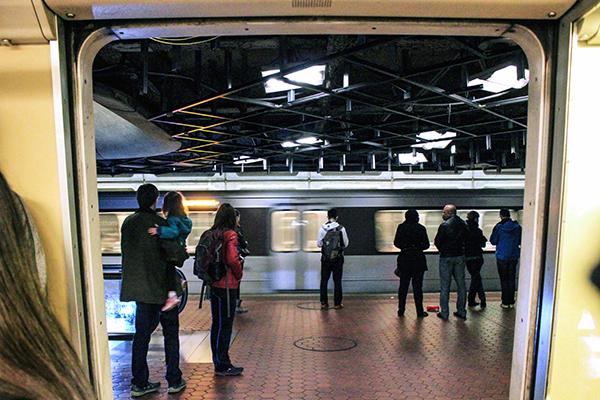The Metro is trying to make riders feel safer by introducing more visible forms of law enforcement in the system.
Officials in the system will buy Metro police bright yellow vests and install more cameras in the underground stations, a spokesman for the transit system’s chairman said. Washington Metropolitan Area Transit Authority’s board members said earlier this year they need to make safety a priority to make more riders confident in the system.
Tom Lipinsky said the increased visibility of police officers in and around the Metro system will give commuters a direct individual to approach when they might feel unsafe. He said there will also be undercover officers on the Metro to increase safety, in addition to the more visible police presence.
“People can go up to police to open up a better dialogue between transit police and people,” Lipinsky said.
Total crime on the metro has increased by 6 percent from 2014 to last year, according to crime statistics from WMATA. The data also shows that total crime has decreased by more than 14 percent overall since 2011.
In a recent incident, four teens set off a fire extinguisher and smoke bombs early Wednesday on the Metro’s Red Line near the Rhode Island-Brentwood station, USA Today reported.
Other attacks include an assault on a 19-year-old male at the Pentagon City station, an assault of a 15-year-old male and his two friends at the Mount Vernon Square station and a robbery of a female graduate student at the Metro bus stop near Trinity Washington University, USA Today reported this week.
“I think there have been a lot of high-profile incidents over the last six months. Crime on Metro is lower than it is in the region, but the last six months there’s been a lot of attention on some particularly disturbing incidents of groups of individuals approaching people alone,” Lipinksy said.
Since Foggy Bottom’s Council member Jack Evans was named chair of the board last month, Evans said one of his biggest priorities for the system is to make it safer for riders. Ridership has been declining to levels not seen in 10 years, according to a report released this month.
The Metropolitan Police Department is also working with D.C. public schools that have been identified as a problem to work with the students and show them how to behave on the Metro. Last week, police arrested two 15-year-olds for assaulting another juvenile on a train Feb. 5.
“There are concerns about attacks with young riders,” Lipinsky said.
The Metro has had previous complaints in the past year after some high-profile safety issues. A Metro car filled with smoke at L’Enfant Plaza last year, killing one woman and injuring 80 people.
In August, a Metro train derailed at the Smithsonian station, causing disruptions on three different lines for most of the day. It was later revealed that Metro employees had discovered the mechanical issue causing the derailment a month before the accident.
A fire at the Stadium-Armory station in September caused delays on several lines for multiple weeks. The federal government seized oversight of the Metro system in October following the safety incidents, The Hill reported.
Graham Jenkins, the vice chair and director of communications from WMATA Riders Union, said that adding and showing off security personnel could help make people feel safe because “it really illuminates the idea that there’s a presence there.”
“Having that presence is not a bad thing, given the lack of consequences and unavailability of personnel that have allowed some hooligans or criminals to do what they’ve been doing lately,” Jenkins said.







